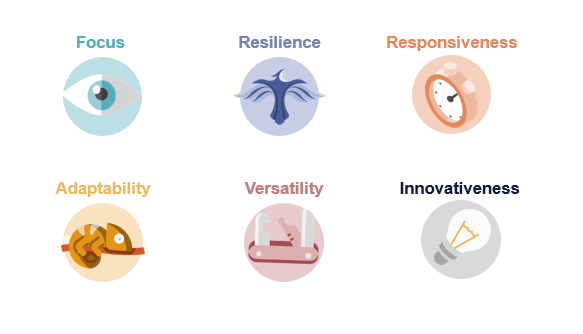In these uncertain times it pays to keep our wits about us – with COVID 19 altering expectations of how we can or should work, new technologies popping up constantly and markets and demographics changing overnight, we need to respond quickly to seize opportunities.
The vital ingredient is Business Agility – the ability to think on our feet, develop new ideas quickly and stay versatile and resilient.
The pandemic has certainly put organisations’ agility to the test - a national telco was forced to close all its call centres to keep staff safe and encouraged customers to use digital self-care. A few months previously, such a change would have been considered impossible, yet the company found it could still thrive in these new conditions.
It requires some transformation of how a company works and thinks, but the benefits are definitely worth the effort – the ability to build the right things, the ability to build those things right and building products and services at the right speed. In fact, making Business Agility part of the business strategy makes companies 71% more likely to grow than those who don’t.
But it’s not all a smooth path – there are rocks on the road to Business Agility in the form of six challenges that businesses need to overcome.
Escaping inertia
Over time, companies will often fall prey to inertia – focusing on risk management and return on investments, they can become complacent and fail to see the exciting opportunities and transforming innovations right in front of them. A classic example is Blockbuster, which turned down a partnership with Netflix because it saw online video rental as niche compared to rental from stores.
Get your story straight
Many companies will fail to communicate the story of the change, jumping into transformation without first explaining to everyone what will happen and why. How can the people tasked with making the change happen work effectively if they do not understand the end goal?
Harnessing motivation
Even if staff understand where the company is going, how do you keep them along for the ride? Money and status don’t cut it – people want to feel in control, they want to be useful and to develop their skills and know that what they do is having a real, worthwhile effect. Businesses who get this right can achieve a 21% higher profitability than those who don’t.
Changing the culture and motivating staff was the central plank in Lego’s turnaround, converting a £217m loss to a £163m net profit in 2008. The CEO recruited Lego fans, flattened the hierarchy and gave creative control to employees.
Coming to terms with change
Not everyone welcomes change – in fact, many fear it and try to avoid it whenever possible. Faced with change, they will go through the stages of shock and denial, anger, bargaining, depression and acceptance. Keeping this process as short and undisruptive as possible means supporting staff at each stage - setting out the vision, keeping them updated and providing a route to make their own suggestions and comments.
Small changes are not enough
When it comes to the new landscape of rapid change, many organisations just don’t get it – they try to deal with new opportunities by sticking with processes and ways of thinking they have always used. It’s understandable – it is far easier to build a business case for cutting operating costs than for an unpredictable return on investment based on test and learn. Yet the fact is that these incremental improvements are simply not transformational enough.
Achieving the right mindset
Some people believe they have a certain level of skill that cannot be significantly improved. Others feel that we can develop these skills through effort, learning and persistence. Developing this positive mindset must come from leaders, who first need to adopt it themselves.
The pillars of Business Agility
Our experience with clients’ projects has shown us that there are six key pillars of Business Agility - Focus, Resilience, Responsiveness, Adaptability, Versatility and Innovativeness.

These pillars help companies overcome the challenges above by changing the fundamentals of the way they operate, think and behave. By configuring the business consistently around Value, Focus and Resilience we ensure stability and drive sustainable performance, even through difficult times.
Responsiveness and Adaptability are the flexible spine of the organisation. These enable the organisation to sense disruption and overcome inertia to seize new opportunities, while continuing to operate the core business. Finally, Innovativeness and Versatility help uncover hidden customer needs and find solutions to remain relevant or lead the way.
How much of each attribute an organisation will need depends on its situation and ambition.
These pillars form the foundations of NTT DATA’s Business Agility framework. Outlined in more detail in our latest white paper, the framework is designed to help executives create a blueprint for change and bring their companies along with them. You may also want to download the "How to make Business Agility a reality" whitepaper, where you will learn more about how Business Agility actually works and its benefits.